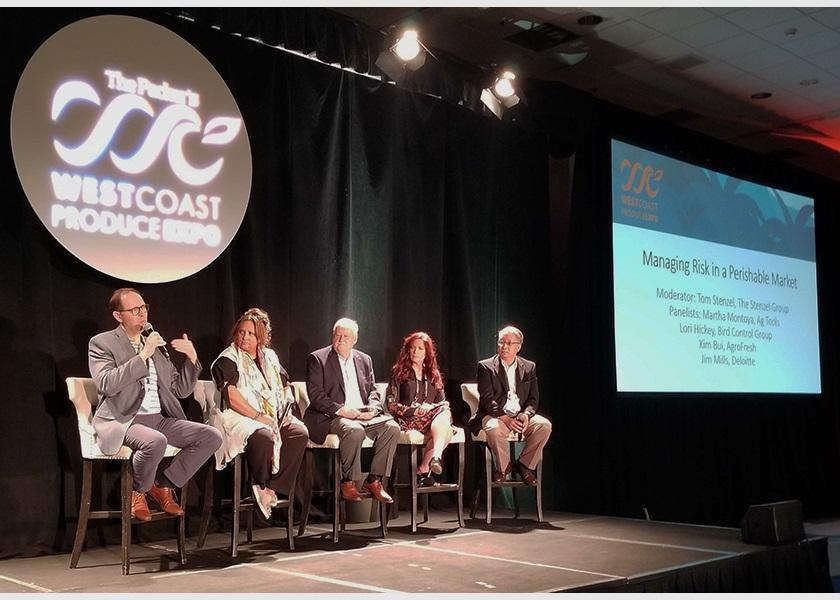Panel says data and collaboration will help prepare for the unexpected

PALM DESERT, Calif. — There is no telling the future, but a group of industry panelists at The Packer’s West Coast Produce Expo considered ways of managing risk in the fresh produce business.
The June 4 panel was moderated by Tom Stenzel, former CEO of the International Fresh Produce Association and the former United Fresh Produce Association and now a consultant with The Stenzel Group.
Stenzel asked panelist Jim Mills, audit and assurance partner for Deloitte & Touche LLP, about how private equity investors evaluate risk in the fresh fruit and vegetable sector.
At times, Mills said that private equity firms invested in the business don’t fully appreciate the volatility of the fresh produce market and instead focus on expected cash flow.
“The ups and downs of the market really can cause years where there are tremendous hits to their bottom lines,” he said. In addition, there are also economic and political risks depending on the location of investments. A firm in Latin America will be exposed to the risks of political and economic instability, labor, water and other realities.
“Part of it is really being able to look at the controllable risks,” Mills said. “It is up to the risk appetite of the organization; can you sustain the ups and downs and the cash flow variability?” Mills said it is important that organizations learn from their mistakes and minimize some of the risks they take on. “I think people are looking to take on risk, frankly, to try and sustain their margins and continue to be competitive in this environment,” he said.
That means being able to process information and data and getting people to talk across the organization, he said.
Panelist Martha Montoya, CEO of AgTools Inc., said the AgTools platform gives customers access to data they need to make decisions. By removing obstacles to data, Montoya said AgTools can make the decision process easier for produce executives.
Panelist Lori Hickey, sales manager for the Western U.S. for the Bird Control Group, said the company uses laser technology to help growers and packers deal with risks associated with bird intrusion in fields and packing houses.
Panelist Kim Bui, global head of FreshCloud Infrastructure and Analytics at AgroFresh, said the company’s FreshCloud platform brings the AgroFresh learnings from 25 years into one place, helping grower/shippers grow and pack the best quality produce and reduce potential market risk.
AgroFresh operates in more than 40 countries, Bui said, and boasts real-time tools and data that can help produce growers maximize fresh produce quality.
Recalling the devastating losses experienced by foodservice suppliers during the COVID-19 pandemic, Stenzel asked the panel about industry reactions and adjustments.
All panelists said the industry must now plan for the unexpected.
“We will have to start looking further out,” Montoya said.
Mills said produce operators have become strong and more diversified because of the pandemic.
Some firms are looking at concentrations of risks within their supply chain, such as being overly dependent on a particular supplier. Other firms are diversifying the commodities they grow.
“We don’t know when the next situation will be around the corner, so we need to take some action now so that we are less vulnerable to it,” Mills said.
Retail response
Montoya said retailers must invest in innovation and help suppliers present new attractive options to consumers.
Retailers also must make sure they understand all the factors that influence their bottom lines, Bui said. For example, understanding where food loss or shrink occurs can lead to steps to cut spoilage, he said.
“I think that is an area where all companies should be looking at data,” he said. However, one element that is currently missing is a common language that outlines key metrics for all retailers. “When you think about how a retailer looks at addressing waste, addressing inefficiencies, they must have a common set of systems, a common unified language, that they can spread across all their different vendors and suppliers,” Bui said.
Trend watcher
Stenzel asked how the industry can spot future trends so they can be in a position to adjust their business priorities.
Bui said that monitoring crop conditions more closely can build knowledge of what could happen again.
“A lot of growers are running full speed at harvest, they can’t afford to sit down and analyze data,” Bui said.
“We synthesize that data, make it super simple for the grower,” he said. “That's another step of getting closer to the point where we can now start predicting the future a little bit better.”
Hickey said the Bird Control Group closely watches weather conditions and how those conditions may affect bird pressure on crops. “We’re constantly looking at the data and try to read ahead and try to predict to be helpful,” she said.
Montoya said industry leaders must identify key pieces of data to spot trends, and then carefully think through the implications of the trends.
“We need to start exercising our brains more,” she said.
Mills said collaboration within a produce company is valuable.
“How do you become a better organization? It is really critical that you have to be able to react quicker and be more practical, not just using the data, but also (how) to secure your decision making,” he said.
Produce companies must bring together their leaders across functions and get the right inputs from all different parts of the organization, Mill said.
“I think bringing those folks together is really critical in trying to understand how to become a quicker, resilient, quicker decision-making organization,” Mills said.







